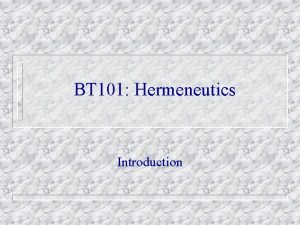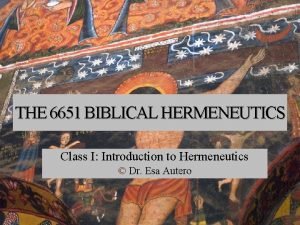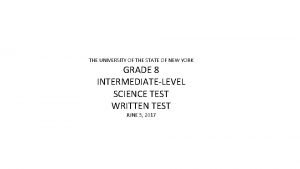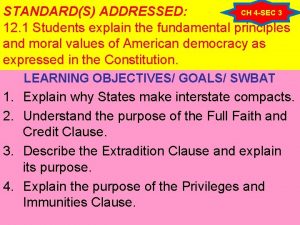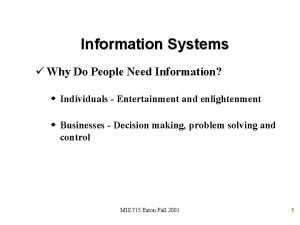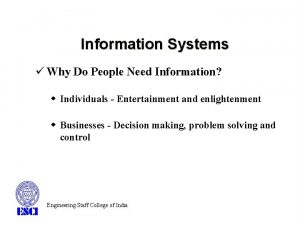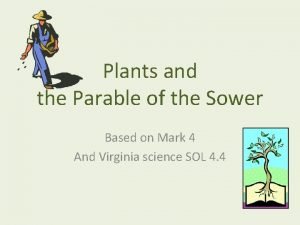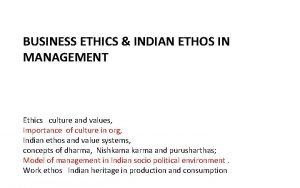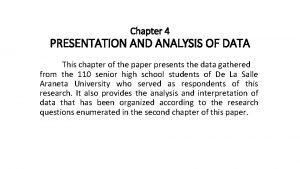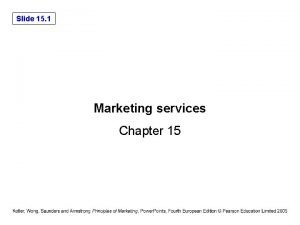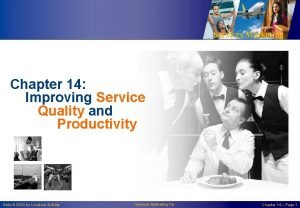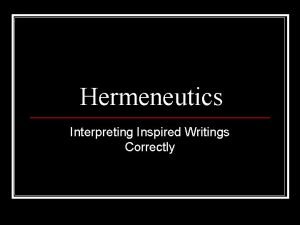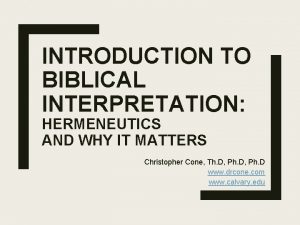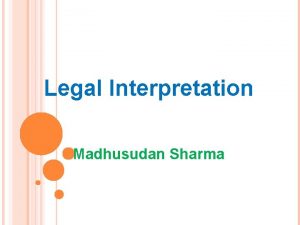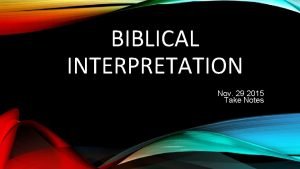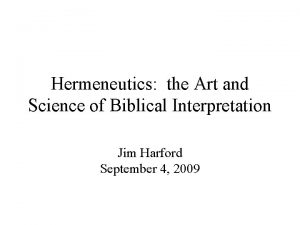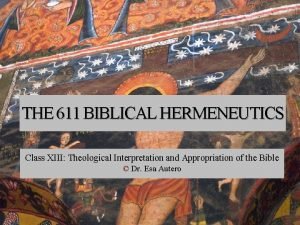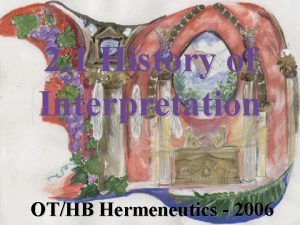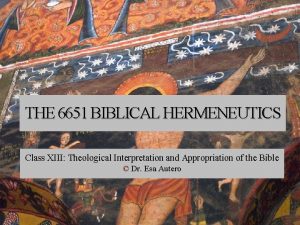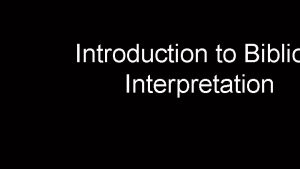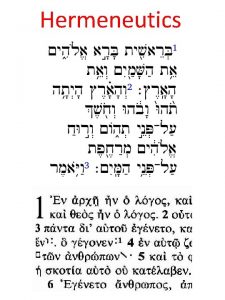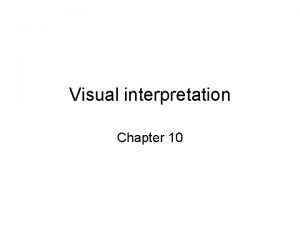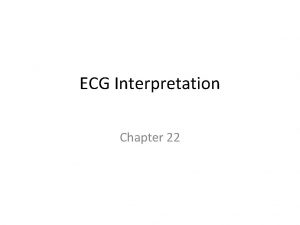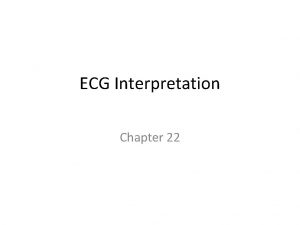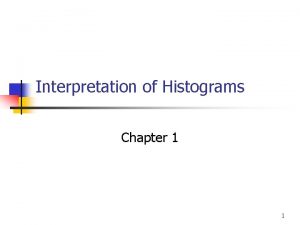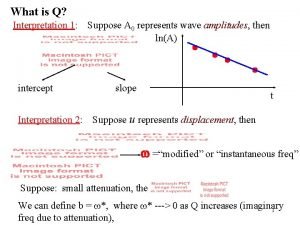Chapter 1 The Need for Interpretation Why Hermeneutics


































































































































































- Slides: 162

Chapter 1 The Need for Interpretation

Why Hermeneutics? • Why do we need to think about interpretation today? • What the Bible says and what the Bible means are different • Christians often differ over how the Bible should influence their lives today • The Scriptures present God’s message, but it is written by humans in diverse places, circumstances, and languages • All interpreters bring certain beliefs and biases to the text

Hermeneutics Defined The term “hermeneutics” describes the principles that can be used to interpret the various forms of communication found in Scripture

Hermeneutics Defined • The hermeneutical process is both an art and a science • Every interpreter brings personal circumstances, presuppositions, and pre-understandings to the text – all such details must be accounted for • The meaning of a message is determined by considering multiple factors: locution, illocution, perlocution

Hermeneutics Defined • The meaning of a message is discerned by considering its: • Content • Purpose • Effect • We must also take into account the interplay of the: • Text • Author • Audience

Some Challenges of Biblical Interpretation • Distance of Time • This highlights the distance between the modern reader and the writing of the texts • The distance between the writing of the texts (or recording of events) and the earlier point in time when such events actually occurred

Some Challenges of Biblical Interpretation • Distance of Language • There is a distance between the modern language of interpreters and the ancient languages of Hebrew, Aramaic, and Hellenistic Greek, in which the Bible was written • A basic difference exists in how these languages function and communicate through their distinctive literary conventions

Some Challenges of Biblical Interpretation • Distance of Culture • This highlights the vast difference between the everyday circumstances of the biblical characters and those of modern day readers • Numerous aspects related to, for example, the political, social, economic, and religious circumstances must be understood if we are to accurately interpret the message of the Bible

Some Challenges of Biblical Interpretation • Geographical Distance • There is a distance between where most modern interpreters live and where the recorded biblical events took place • Some of these places are now inaccessible

Eternal Relevance • The Bible is God’s word to his people • Therefore, the interpreter must be attentive to God’s intention to communicate divine truth through the Bible

The Goal of Hermeneutics • The goal of hermeneutics, in light of the eternal relevance of the Bible, is: • To allow the interpreter to understand the original meaning of the text • To help the interpreter comprehend the significance of the text’s meaning

The Goal of Hermeneutics • The significance of the text: • Applies to the personal life of the interpreter • Applies to the life of the church more broadly

Chapter 2 The History of Interpretation

Jewish Interpretation • The ancient Israelites who wrote and edited what would later become the Hebrew Scriptures used a process sometimes called inner biblical allusion • During this process, texts that were accepted as authoritative were revised and updated to address the challenges of a new generation; the result was that both the original (source) text and the revised text were accepted as authoritative

Jewish Interpretation • Interpretation during the transition into the intertestamental period was dominated by: • The production of Targums (the translation and interpretation of the Hebrew Scriptures into their vernacular language of Aramaic) • The vigorous study of the Pentateuch in Hebrew by scribes and rabbis

Jewish Interpretation • By the NT period at least three interpretive schools were discernible, each demonstrating an attempt to hold tight to their Jewish identity in response to the changing world around them • Hellenistic Judaism • Allegorical Method • Septuagint • Qumran • Prophecy • Pesher • Rabbinic Judaism • Mishnah, Abot, Talmuds • Literal interpretation, Midrash

The Apostolic Period (ca. AD 30 -100) • The first Christian interpreters attempted above all to demonstrate the validity of their beliefs about Jesus from the OT Scriptures • The fundamental hermeneutical principle was Jesus’ literal fulfillment of OT prophecy

The Apostolic Period (ca. AD 30 -100) • But at least three other interpretive approaches were also employed: • Typology • The identification of patterns, symbols, and events in the OT thought to be anticipating God’s activity later in history through Jesus • Literal-Contextual Interpretation • An OT passage is interpreted within its original context and according to its normal meaning • Principle/Application Method • A passage from one context could be interpreted in light of an underlying principle that was comparable to the situation of another context

The Patristic Period (ca. AD 100 -590) • This era can be differentiated into three subperiods: 1. The subperiod of the apostolic fathers highlights the writers from the first half-century after the death of the apostle John. It evidences four interpretive approaches: • • Typology Allegory Midrashic tendencies Traditional interpretation • Since there was not yet a completed canon of Scripture, church tradition offered the only firm basis through which the correct teaching of the apostles could be explicated and defended against alternative heretical interpretations

The Patristic Period (ca. AD 100 -590) 2. The Alexandrian School (ca. AD 150 -400) • The allegorical method had become the dominant methodology 3. The Church Councils (ca. AD 400 -590) • Church leaders appealed to the principle of “apostolicity” - that as the apostles’ successors, only they were the true interpreters of Scripture since only they had received the apostolic teaching • This served to solidify further the prominent role of traditional interpretation in the Western church • Augustine contended that the literal or historical meaning of a text was primary for proper interpretation • Jerome completed the Vulgate, which become the official Bible of the Western church and basis for Catholic doctrine

The Middle Ages (ca. AD 590 -1500) • Three interpretive methods were prevalent • The allegorical method continued to dominate interpretation • The traditional interpretation method continued to bolster accepted doctrinal understanding of texts in the church • The method of historical and literal exegesis continued to be used, often with the aid of Jewish interpretation

The Middle Ages (ca. AD 590 -1500) • Around this time the movement called scholasticism emerged with a concern to discern the relationship between the Christian faith and human reason • Thomas Aquinas, who would become the most important spokesman for scholasticism, heavily emphasized the need for a literal hermeneutic • Aquinas’s influence may have pointed the Middle Ages on a trajectory toward the Reformation

The Reformation (ca. AD 1500 -1650) • Major developments: • Advances in both Hebrew and Greek allowed for a renewed examination of the Scriptures in their original languages in this era • Erasmus published the first modern edition of the Greek NT in 1516 • A growing interest in early manuscripts exposed numerous translation errors in the Latin Vulgate, dealing a blow to its absolute authority in supporting Catholic Church doctrine and to the absolute authority of the Catholic Church itself

The Reformation (ca. AD 1500 -1650) • Martin Luther’s threefold contribution • By arguing that Scripture is its own best interpreter, Luther affirmed Scripture - and not church tradition - as the ultimate authority for the Christian life and established the central Reformation principle of sola scriptura • Luther rejected the allegorical method of interpretation in favor of one that sought to understand the text within its original historical context using standard grammatical rules • Luther emphasized the role of the Holy Spirit in the process of interpretation

The Reformation (ca. AD 1500 -1650) • Other developments: • Groups such as the Anabaptists and Mennonites applied the Reformation principles of sola scriptura in new hermeneutical directions by giving priority to the NT and reading it literally • The Catholic Church responded at the Council of Trent by upholding the authenticity of the Vulgate and forbidding all interpretation of Scripture that is out of harmony with church doctrine

The Post-Reformation Period (ca. 1650 -1750) • Major Developments: • Pietistic movements sought to reject the dryness of scholasticism by cultivating Christianity as a way of life through group Bible study, prayer, and an emphasis on personal morality • The Renaissance was producing the Enlightenment and a movement called rationalism, the latter of which emphasized the human mind as an independent authority capable of determining truth • The effect of rationalism thereby set human reason over religion and over Scripture

The Modern Period (ca. 1750 -Present) • Nineteenth century developments: • Radical advances in science encouraged the use of a more scientific method for studying history and the biblical text, the latter phenomenon coming to be known as the historical-critical method • Undergirded by a view of reality that explained everything in terms of natural laws, interpreters began to treat the Bible like any other piece of literature, thereby excluding the possibility of all supernatural events • With the validity of its theological and historical claims stripped, the Bible was reduced to a source for moral and ethical values • Two shifts in biblical interpretation: • scholarly focus shifted from attempting to discern what a text meant to discovering the sources behind it (source criticism) • denying the Bible as a divine revelation, some interpreters instead endeavored to explicate the various texts’ (presumed) undergirding historical development

The Modern Period (ca. 1750 -Present) • Twentieth Century Developments: • New attention to the history of religions offered insight into the various religions contemporary to the Bible; this resulted in a better understanding of the ancient character of the OT texts and of the importance in comparing the Bible with surrounding cultural evidence • Form criticism came to offer valuable assistance to interpreters when their focus shifted to the literary types of the OT and the Gospels

The Modern Period (ca. 1750 -Present) • Developments between the end of WWII and the dawn of the twentyfirst century: • The Biblical Theology Movement forced a reconsideration of the Bible’s overall unity and, perhaps above all else, revived the study of theological dimension of the Bible • The emergence of redaction criticism enabled interpreters to try to discern the distinctive theological emphases of the individual biblical writers or editors • The “new quest for the historical Jesus” movement attempted to delineate what the Gospels might detail about the historical person of Jesus • the “new hermeneutic” implied a different view of the biblical text in which the text guides interpretation and grips the reader, rather than the reader guiding interpretation and controlling the text with his or her questions

The Modern Period (ca. 1750 -Present) • Developments between the end of WWII and the dawn of the twentyfirst century (cont. ): • The “new hermeneutic” implied a different view of the biblical text in which the text guides interpretation and grips the reader, rather than the reader guiding interpretation and controlling the text with his or her questions • Canon criticism was developed to discern theological meaning of the books of the Bible by examining its canonical shape • New literary approaches and new sociological approaches have all pushed the discussion about interpretive methods into new horizons

The Modern Period (ca. 1750 -Present) • Developments in the twenty-first century: • Interpretation from the perspective of gender orientation (e. g. , queer hermeneutics), interest in intertextuality studies, and interest in the Bible’s reception history – to name a few – have all flourished • Theological Interpretation of Scripture aims to recover the Bible’s theological voice and the viability of interpreting Scripture theologically with the aid of pre-critical and pre-reformational voices • Other methods, like the redemptive-movement hermeneutic, the hermeneutic of transformation, and an interest in the relationship between exegesis and ancient spiritual practices, have all generated significant interest

Chapter 3 – Literary and Social-Scientific Approaches

Literary Criticism • Literary criticism is a wide-ranging category • It includes numerous methods that are ahistorical in nature, focusing only on the final form of the text without regard for details such as authorial intention or the text’s historical background information • Two such approaches include narrative criticism and poststructuralism

Literary Criticism: Narrative Criticism • Narrative criticism closely resembles the critical methods used to study the great literary classics • It examines the features of a text such as plot, theme, characterization, symbolism, foreshadowing, etc.

Literary Criticism: Narrative Criticism • While narrative criticism generally focuses more on a text’s artistic value than on its moral or theological value, it remains very useful to readers of the Bible • For example, attention to the development of a character in a narrative can shed light on whether or not the author wants readers to identify with or imitate him or her • The focus on the final form of a text, which in narrative criticism is regarded as a unity, is helpful, since it is the final form of the biblical book that is inspired and authoritative

Literary Criticism: Narrative Criticism • Pitfalls • It has a tendency to undermine a narrative’s religious value in favor of its aesthetic value • It tends to regard the literature of the Bible as fiction (even though this grossly misunderstands the relationship between historical and fictional texts in antiquity)

Literary Criticism: Poststructuralism • A form of literary analysis that finds meaning to be the product of individual readers or interpretive communities rather than as residing in a text • The two major categories of this type of analysis include reader-response criticism and deconstruction

Reader-response criticism • Focuses on the various ways readers respond to a text and affirms that meaning derives from the interaction between a text and its readers • A conservative form of reader-response criticism may attempt, for example, to aid a reader in exploring the “gaps” in a text which require the reader to supply his or her own meaning • A more radical reader-response criticism may completely detach objective meaning from the symbols of the text in favor of ultimately reading into it a foreign meaning from the individual reader or interpretive community

Deconstruction • Seeks to demonstrate how all human communication, and therefore all texts, ultimately undermine themselves, or deconstruct • May be used to dispute that a text has a fixed meaning by highlighting any subtle ideological inconsistencies or ambiguities that might be hard to resolve • Such intentions leave deconstruction with very little value for interpreters with a traditional view of Scripture’s inspiration or authority

Social-scientific approaches to Scripture • Interpreters have also turned to social-scientific models of inquiry (e. g. , sociology, anthropology, economics, political science) to gain new insights into the biblical text • Social-scientific studies fall into two categories: • Those that explore the social history of the biblical world • Those that apply modern theories of human behavior to biblical texts

Social-scientific studies that explore the social history of the biblical world • These seek to cast new light on a text by obtaining a better understanding of the social world out of which it comes • Examples of the kinds of dynamics studied: • • • Family Religious Political Cultural Honor and shame Ritual purity

Social-scientific studies that apply modern theories of human behavior to biblical texts • These apply modern theories about human behavior to biblical texts in an attempt to understand the various social dynamics that may have been operating and can lead to significant new insights into the text • Examples include • • Sociology Anthropology Economics Political science

Advocacy Groups • Several other subdisciplines have developed within the broader arena of social-scientific inquiry • Each may be said to share: • A common commitment to the liberation of the disenfranchised within the world • A view of the idea of a detached objective approach to interpretation as nonsensical • Examples: liberation hermeneutics, cultural criticism, feminist hermeneutics, and LGBT hermeneutics

Advocacy Groups • Liberation hermeneutics • Begins with the experience of the injustice of poverty and attempts to analyze the reasons for such an impoverished existence • Often embraces biblical narratives depicting liberation from oppression such as the exodus narrative • With a belief that God sides with the oppressed, liberation theologians call on believers to work towards a more humane society on earth today • Cultural criticism: Postcolonialism • Emerged in former Asian and African colonies • Emphasizes the emancipation of the subjugated and prioritization of the marginalized • Accepts pluralism among religious worldviews

Advocacy Groups • Feminist hermeneutics • Evangelical (or biblical) feminists maintain that, before the fall and after redemption, the biblical teaching best describes the full equality of the sexes and does not delineate unique roles based on gender • Non-evangelical Christian feminists may either refuse to accept certain texts as authoritative and/or focus on other more “programmatic” texts which they see as teaching complete equality • LGBT hermeneutics • Views on homosexual behaviors range from those who find the Bible’s teaching on homosexual practices to be mistaken (or that it was meant to be applied in less than a timeless fashion) to those who think its teaching was timeless but simply reject it

Chapter 4 – The Canon and Translations

The Biblical Canon • The phrase “canon of Scripture” refers to the collection of biblical books that are accepted as authoritative by Christians • Since Protestants, Catholics, and Orthodox Christians disagree as to which books should be included, the question of the canon pertains to how we know we have the right books

The Canon of the Old Testament • Since the Reformation, Protestants have accepted an OT canon that includes 39 books • Roman Catholic and Eastern Orthodox Christians include additional literature known as the apocrypha, which was influential during the early period of church history • Protestants defend their OT canon on the basis that these 39 books were the only books used by Jews in the time of Jesus and were accepted by the apostles

The Canon of the Old Testament • Evidence from the council of Jamnia points to the likely reality that Jews agreed upon what was included in the OT canon by the early or mid-first century AD • English Bibles follow the arrangement of the Septuagint, such that the books of the Prophets and Writings are interspersed with each other

The Canon of the New Testament • The recognition of a developing NT canon began early (see how 1 Timothy 5: 18 cites Luke 10: 7 and the reflection on Paul’s writings as Scripture in 2 Peter 3: 16), but its final shape took centuries to agree upon • In the second century, such challenges as the spread of Marcion’s beliefs, the rise of gnostic writings about secret post-resurrection revelations from Jesus, and the persecution of Christians forced Christians to begin delineating the shape of the NT canon

The Canon of the New Testament • Around AD 150 Christians began producing lists, such as the (socalled) Muratorian Fragment, which identify the books that were to be regarded as Scripture • In AD 367 Athanasius became the first known Christian writer to endorse all 27 of the NT books without hesitation, and the subsequent Councils of Hippo (AD 393) and Carthage (AD 397) ratified his views • Thus the traditional boundaries of the NT canon have been well established since the fourth century AD

Ordering of the New Testament Canon • The four Gospels were placed first to describe the origins of Christianity in the life of Jesus • The historical development of the movement described in the book of Acts was placed next • The Pauline epistles are differentiated into two groups, with one addressing churches and the other addressing individuals; they are generally organized in terms of decreasing length • Hebrews follows the Pauline epistles and it is in turn followed by James, Peter, John, and Jude. These epistles are organized by decreasing length and perhaps by the descending order of their authors’ prominence in the earliest church • The focus on the end of history in the book of Revelation provides a fitting conclusion to the canon

Criteria of Canonicity • The criteria for the canonicity of the NT may be helpfully understood in the following terms: apostolicity, orthodoxy, and catholicity • Apostolicity - All of the NT books were believed to have been closely associated with those who were considered apostles (including Paul) or with a connection to Jesus, and came from the apostolic age (first century) • Orthodoxy - Christians believed that the NT books as a whole offered a coherent theological and ethical message • Catholicity – This refers to the perceived usefulness of each book to a wide range of churches from the earliest generations of the faith • The process of canonization did not impute the biblical books with authority; rather, the books with recognized authority were admitted to the canon

Canon Criticism • A process which seeks to interpret the biblical texts in light of their final form • Examines how the final form of a text has been shaped by its author or editor; it can also focus on the final form of the text in terms of its placement within the broader OT or NT canon • Offers a helpful renewed emphasis on the unity of the Scriptures and draws attention to Bible’s important theological topics

Texts and Translations • For students without training in the biblical languages, who must rely on a translation of the biblical text, it is important to consider two things: • The extent to which their translation utilizes the most accurate findings of modern textual criticism • What kind of translation they are using

Texts and Translations • The process of textual criticism seeks to determine, by weighing and comparing all available manuscript evidence, what the original words of the Bible actually were • It is necessary because the original autographs no longer exist • Instead, we have copies of copies (etc. ) of the original autographs and these copies were produced by hand • In the process of making these copies, scribes occasionally introduced unintentional errors, such as when letters, words, and lines were omitted • In a real sense all other methods of biblical interpretation rely on textual criticism

Texts and Translations • To understand how translation is done we need to take into account two important factors: accuracy and clarity • Formal equivalency refers to a translation principle that prioritizes preserving the form and structure of the original text over the result of a polished English translation (e. g. , NASB) • Dynamic equivalency refers to a translation principle that seeks to prioritize clarity of English translation over grammar and syntax, while still being true to the meaning of the text (e. g. , NLT) • Optimal equivalency refers to a translation principle that prioritizes neither clarity over accuracy nor accuracy over clarity but seeks to attain as much of each as possible in every passage (e. g. , NIV)

Chapter 5 – The Interpreter

Qualifications of the Interpreter • Certain qualifications are necessary for one to be properly positioned to yield valid interpretations of the Bible • One must know God and believe that he speaks through the Bible for a full understanding of it • One must possess a willingness to submissively hear and respond to what God reveals in the text

Qualifications of the Interpreter • Qualifications (cont’d): • One must be willing to allow the Holy Spirit to work in the exegetical process • One must recognize the need for membership in the local and global church • One must employ appropriate methods for proper interpretation

Presuppositions for Correct Interpretation • All readers approach texts with underlying assumptions that govern (and even determine) their interpretations • As such, it is hugely important to identify and consciously adopt the presuppositions that one agrees with and can defend • Otherwise the interpreter will uncritically maintain and employ the presuppositions they have, which may or may not be adequate and valid

Presuppositions about the Nature of the Bible • The Bible is a revelation of God’s message that is inspired by God himself: a supernatural book given to his people through the work of divinely inspired human authors • The Bible is authoritative and true; it possesses ultimate authority and provides the standard for human belief and behavior • The Bible is a spiritual document which manifests unparalleled spiritual worth and a capacity to transform lives through the Spirit’s aid

Presuppositions about the Nature of the Bible (cont’d) • The Bible is an overall unity even while its contents are diverse • The Bible is an understandable document; it is accessible in all that it intends to communicate to the reader • The 66 books of the Protestant canon constitute God’s scriptural message; these books are to be given hermeneutical priority in interpretation and authority

Presuppositions about Methodology • While students of the Bible should employ all methods that assist in arriving at an accurate understanding of the meaning of the text, certain methods may conflict with the interpreter’s presuppositional beliefs about the nature of Scripture • These may require modification or rejection • When an interpretive technique is merely neutral as it relates to one’s presuppositions, it should be used insofar as it yields results in the pursuit of the biblical text’s meaning

Presuppositions about the Goal of Hermeneutics • The ultimate goal of hermeneutics is to arrive at the meaning the authors (or editors) intended their original audience to understand • At the same time, the Bible speaks today as the text’s significance grows out of the original meaning

Pre-understandings of the Interpreter • All interpreters approach a text with certain views of the world that are based on their previous experiences, training, and thinking • Everything, from, for example, one’s language, gender, cultural values, physical environment, and political allegiances, contributes • These views, whether true or false (or some combination) and whether recognized or unrecognized (or some combination), function as a lens • This lens colors everything the a person encounters and influences how he or she makes sense of new experiences, including how the interpreter understands their reading of the biblical text

Pre-understandings of the Interpreter • It is crucial to recognize, as much as it is possible, these preunderstandings so that they do not improperly determine the meaning of the text in one’s act of interpretation • The interpreter must be willing to adjust, revise, or even reject erroneous pre-understandings, while embracing new ones • The goal is to let the meaning and significance of the biblical text further shape one’s understanding of reality

Pre-understandings of the Interpreter • To know whether his or her pre-understandings are valid, the interpreter must test his or her pre-understandings to examine whether they correspond to the biblical data • A Christian pre-understanding is informed by a commitment to the Christian faith, which, in its commitment to the Bible as God’s true and authoritative revelation, provides the boundaries for the believer’s reading of the Bible • This is an informed circularity

Pre-understandings of the Interpreter • The goal of all interpreters should be an ever-growing, biblically oriented pre-understanding of the Bible itself that enables further insights into the meaning of its texts and message • This happens as one’s pre-understandings are continually shaped by new understandings gained from Bible study • With the new pre-understandings in place, the interpreter can further engage the text with new questions and allow the answers and insights to further transform and shape their pre-understandings

Chapter 6 – The Goal of Interpretation

Speech Acts • Human communication comprises what are sometimes called “speech acts” • Speech act theory distinguishes communication into three elements that together comprise a message’s meaning: • The locution (the words, sentences, genre [etc. ] of what is actually spoken or written) • The illocution (the intention the author or speaker has for those words in the form and with the kind of energy employed) • The perlocution (the author or speaker’s desired or intended response or outcome for the recipients of the message)

Meaning in a Locution • There are three potential aspects of meaning in a locution: • The meaning the author intends to convey • The actual grammatical and lexical meaning of the words written • The reader’s understanding of the meaning • These aspects raise important questions, since, for example, the author may not accurately formulate his message (the locution) in a way that matches his intent (illocution), or, alternatively, the reader’s understanding may not accurately reflect the author’s intention or the text’s meaning

Levels of Meaning • It is necessary to distinguish between authorial intention, textual meaning, and perceived meaning • Authorial intention – this refers to the meaning a message or text has that comes from what the author intends to convey • Textual meaning – this refers to the actual meaning that is conveyed by the words and grammar of the text • Perceived meaning – this refers to the meaning the reader understands

Levels of Meaning • Normally the reader of a message will aim to understand what the author intended • However, we often do not have access to the author’s mind, but only the text • Thus in biblical interpretation, an important point is that the goal of interpretation is to understand the meaning of the text with the recognition that it has been encoded by an author or editor to accomplish some purpose • Author/text centered methods (such as historical, grammatical, literary, cultural, etc. ) must be central to examining a message’s meaning, including its illocutionary and perlocutionary effects

Can a Text Have Multiple Meanings? • The distinction between meaning and significance must be maintained • While it can have multiple points of significance, a text has only one meaning (unless it is otherwise clear that the author intended more than one) • What about the instances where it seems evident that a later writer assigns meaning beyond the original author’s historical sense? • In such cases, the NT authors used interpretive techniques derived from their Jewish background (such as midrash, pesher, and typology) to envision new meanings

Author-Centered Textual Meaning • Biblical authors generally wrote texts with a single meaning as they conveyed specific content to effect responses from their readers • This author-encoded historical meaning is the central objective of hermeneutics

Author-Centered Textual Meaning • The textual meaning of a text (a locution) refers to that which the words and grammar of the text disclose regarding the probable intention of its author/editor (the illocution and perlocution) and the likely understanding of that text by its intended readers • Thus, while a number of reader-oriented interpretive approaches may attempt to locate the meaning of the text within the reader’s experience with the text, only the author-encoded meaning of the text can be legitimately considered the inspired message of God

Author-Centered Textual Meaning • At the same time, the author- and text-centered approach requires the interpreter to study the Bible as literature • The writer’s message is encoded in the form of certain known genres that must be appreciated and understood in light of the ancient customs • Literary considerations are complementary and equally important to the historical concerns about the world of the author and text • Interpreters must be willing to accept the historicity of an account on the basis of how the author/editor intended it to be read and how the original readers would have interpreted it in light of the literary and textual conventions of the day

The Place of the Reader in “Constructing” Meaning • What is the role of the interpreter or reader in the process of discovering meaning? • If NT authors found meanings in addition to the original meaning of the OT author, can we replicate this practice today? • Readers approach texts with different experiences that have shaped their pre-understandings and presuppositions

The Place of the Reader in “Constructing” Meaning • While two readers can be guided by the goal of determining the author’s intent for a text, they may perceive the author’s meaning differently • They may be driven by an unconscious desire to view the evidence in a certain way or a blindness to other alternatives (or both) and this influences their execution of the interpretive process • While the historical meaning of the text is our goal, we must be open to the idea that a text with a single purpose (or illocution) can generate multiple perlocutions that go beyond the one the original author intended

Validating Our Interpretation • How then can one know whether his or her understanding of a passage is correct? • Since we no longer have access to the original author or audience, this question is difficult to answer with absolute certainty

Validating Our Interpretation • With the established goal of determining the historical meaning of the text that was intended by the author, we can say that the most probable interpretation of any given text will be consistent with the use of language and literary genre at the time the text was written • We must account for any personal biases which may inappropriately color our interpretation, as much as it is possible to do so • One may do this by reading widely about a subject or passage or by consulting the broader church community about one’s conclusions, to name but two options

Validating Our Interpretation • If at the end of this process we still remain in disagreement with other believers about the particular meaning of a text, then Christian grace must prevail: • We should acknowledge that both options are possible and agree to disagree as we support the other in the life of faith and work of the Gospel

Chapter 7 – General Rules of Hermeneutics: Prose

The Literary Context • One basic principle of interpretation is that the intended meaning of a passage must be consistent with the broader literary context in which it occurs. Three factors support this: • The broader literary context establishes the author’s flow of thought and to take a passage out of context violates this flow of thought • As individual words generally can have more than one meaning, it is the literary context that serves as the most reliable guide for determining the meaning of the words used • As words, individual sentences, and paragraphs together develop the larger arguments of a biblical book, context helps determine the correct relationship between these units

The Literary Context • To qualify as the text’s intended meaning, one’s interpretation must be compatible with the flow of thought and the particular intention of the immediate context and the larger book context • To interpret a text without any reference to its context is to be liable to abusing the meaning of the text, and the smaller the passage being studied, the greater the chance of error

The Literary Context • In order to interpret a passage in its literary context, one must recognize and examine the passage in at least three stages of context: • First, the immediate context, which is that material immediately before and after the passage, exerts the most important influence over the meaning of the passage • The second stage is the context of the entire biblical book: the passage must be understood in terms of the message of the book overall • The interpreter should pay attention to the book’s controlling themes, its basic outline, and any parallel passages that deal with the same subject as the passage under examination • Lastly, the context of the entire Bible provides the final measure of literary context • The correct meaning of a passage should be consistent with the larger teaching of that subject

Historical-Cultural Background • The correct interpretation of a passage in Scripture must also be consistent with the historical-cultural background of the passage • Three points spell this out: • First, since the circumstances in which communication occurs substantially control meaning, it is necessary to comprehend the perspective of the original communicators (the author and readers) to understand the correct meaning • To do this, the interpreter must understand as much as possible about the details of the message’s historical and cultural background

Historical-Cultural Background • Second, to understand both the content and the intended impact of a passage of Scripture, we must be aware of the mindset of the original communicators, and this requires an understanding of the historical-cultural background of their world • Finally, the interpreter is prepared to contextualize a text’s meaning only when he or she understands the background of the biblical world well enough to express and apply the meaning in contemporary culture

Historical-Cultural Background • A number of principles guide the interpreter in the process of attempting to contextualize a text’s meaning: • Interpreters must understand each passage in a manner that is consistent with its historical and cultural background • The (emotional) impact the message would have had in its original message must be determined • The interpreter’s conclusions must be communicated through modern language in ways that closely correspond to the ideas of the original culture • The interpreter must be careful not to let the exploration of the historicalcultural background force a conclusion that is inconsistent with the evident intention of the author

Historical-Cultural Background • The process for studying the historical-cultural background has two main parts: • Studying the background of a biblical book • The interpreter should become familiar with details about the author/editor, the recipients, date of composition, and purpose of the book • Investigating the background of the specific passages in the book • The historical background study of a particular passage may go more in depth; it should always be consistent with the historical setting of the book as a whole • To the extent that the interpreter can enter the world of the biblical setting to understand the situations of and relationship between the writer and audience, he or she can grasp the meaning of the text

Word Meanings • Words also play a central role in the process of interpretation • Indeed, the correct interpretation of the Bible is based on the normal meaning of words in their contexts • For correct interpretation, it becomes crucial that the interpreter seeks to understand the words of a passage in the way the author uses them, with the meaning they would have had at the time of writing • Since a single word can have a range of meanings, context is crucial for determining which meaning makes the best sense

Word Meanings • The process for conducting a word study begins with identifying the words that are most important to study • These may be difficult or rare words, or words that appear to be theologically loaded • Once the word is selected, the interpreter should determine the range of meaning the word could have through consulting a lexicon • Then, once the range of meaning is understood, the specific meaning of the word should be compared to other words in its field of meaning and with any non-biblical uses of the word there may have been at the time of writing • With all these steps completed, the interpreter should identify the meaning that best fits the context in which the word is used

Grammatical-Structural Relationships • The final component that must be assessed to determine a writer’s meaning is the grammatical-structural relationships of the literary units (words, sentences, paragraphs, etc. ) • The two main elements involved in grammar are morphology and syntax • Morphology pertains to the forms of individual words and how they change (or are inflected) to indicate their function in a language (e. g. , changing “pick” to “picked”) • Syntax denotes the system a language uses to combine its various elements in order to communicate

Grammatical-Structural Relationships • Word order, the forms and combinations of words, and how various connecting words mark the relationships between words, sentences, and even paragraphs in a larger discourse all contribute to meaning

Grammatical-Structural Relationships • It is also important to understand the structural relationships that are operating in the author’s writing • After identifying the natural divisions of a section, the interpreter should seek to trace the author’s flow of thought in the section through an examination of how the sentences develop a writer’s point(s) in each paragraph • Attention should be given to the various types of logical relationships the sentences may have (e. g. , temporal, causal, comparative, etc. )

Grammatical-Structural Relationships • Attention should also be given to the force of the verbs used by the authors, including their mood, aspect, and time • Finally, the interpreter must pay attention to the connectives, adjectives, adverbs, and pronouns that are employed

Chapter 8 – General Rules of Hermeneutics: Biblical Poetry

The Dynamics of Poetry • Poetry is the second most common form of literature in Scripture, making up nearly one-third of the Bible • The distinctive features of poetry include its terseness, the vivid and inventive choice of words, and a high degree of structure • The vivid language of poetry aims to impact the reader’s imagination more than his or her reason; the reader should experience the topic through the images given • The interpreter’s task, when it comes to biblical poetry, is to understand the poetry’s sound, structure, and language

The Dynamics of Poetry • In English poetry, sound is analyzed in terms of its rhyme and meter • Rhyme depicts the pairing of at least two identical sounding words at the end of successive or alternating lines • Meter references the movement between accented and unaccented syllables in each line

The Dynamics of Poetry • Hebrew poetry differs in two significant ways • First, it does not follow a structured system of rhyming, but rather uses rhyming occasionally and with great effect • Second, its use of meter is quite flexible • Attention to rhyme helps the interpreter recognize the additional dimensions and movements of a text

The Dynamics of Poetry • Biblical poetry also uses the sounds of words to create poetic effects • The biblical authors regularly employed assonance (repetition of vowel sounds) and alliteration (repetition of consonants) in their poetry (and poetic prose), often times creating memorable wordplay • Other memorable examples of this kind of wordplay include the repetition of words and the use of onomatopoeia (a word that sounds like the action it depicts) • By giving attention to the words the author emphasized through these methods, the interpreter may find important clues about the passage’s meaning

The Structure of Hebrew Poetry • Parallelism is a term that describes when two or more successive lines (or stichs) of a poem strengthen, reinforce, and develop the thought of the other • Often the second line further develops, defines, or expands the first

The Structure of Hebrew Poetry • There are three main variations of parallelism, each of which can be : nuanced further • A first variation of parallelism (A=B) occurs when lines A and B are interchangeable, as B either echoes or contrasts A • A second variation of parallelism (A > B) occurs when A states the main idea and B qualifies it, bringing the thought of A to completion • A third type of parallelism (A < B) occurs when A prefaces the main idea and B develops the main idea in a way that complements or completes A • The reader that gives due attention to these features of parallelism will better understand how structure contributes to a poem’s communication

Other Poetic Structures • Numerous other structures are used in biblical poetry • Chiasm – A device in which the word order of a parallel line is the reverse of its predecessor • Merismus – A device that occurs when a writer mentions the extremes of some category in order to portray it as a totality – those opposites and everything in between them • Inclusio – A device that frames a poem (or narrative) by repeating words or phrases from its opening lines at its conclusion

The Language of Poetry • Proper interpretation requires examining how biblical poetry uses language • One aspect of its use of language is imagery • It is crucial to recognize that poets effectively “paint” pictures with their words; it is these concrete images from everyday life make that their communication so powerful and memorable

The Language of Poetry • Another observable characteristic of poetry is its use of numerous devices • Poetry frequently employs similes of various kinds (simple, paired, extended) to compare two things (using “like” or “as”) • A poem may also draw a comparison in a more straightforward manner with the use of a metaphor or a string of metaphors • In both cases, interpretation must be guided by literary and historical-cultural context

The Language of Poetry • The poem may also include devices such as personification or the use of an apostrophe, of hyperbole, metonymy, synechdoche, or irony • To interpret such a wide range of figures, the interpreter should do the following: first attempt to identify the type of figure, then try to distill the figurative meaning from the literal meaning, and finally work to determine the figure’s function

Larger Units of Poetry • Larger units of poetry will need to be broken down into their smaller constituent parts so that these steps of interpretation may be taken and the development of a larger passage can be traced and its main themes understood

Chapter 9 – Genres of the Old Testament

The Nature of Genre • Knowing the genre of a text will provide the interpreter crucial information about how the text will look and how it properly functions • The many types of genres found in the Old Testament literature include Narrative, Law, Poetry, Prophecy, and Wisdom

Narratives • Narratives are the most common form of literature found in the OT, comprising one-third of its contents • Narratives themselves occur in many forms in the OT, and these may be differentiated in terms of reports and heroic narratives • Reports function as a building block of narrative by describing the basic facts of what happened • Examples of reports may include anecdotes, battle reports, dream or epiphany reports, historical stories, etc.

Narratives • Heroic narratives sketch some of the episodes that comprise the life and exploits of an important figure, such as their birth, marriage, life work, or death • These narrative depictions can be positive or negative and thereby emphasize the need to emulate or avoid • The heroic narrative may be offered in the form of an epic, prophet story, comedy, or farewell speech, to highlight but a few

Law • The Law (or legal materials) is one of the major categories within which narratives are employed in the OT • The Law functioned to outline how through obedience Israel could enjoy God’s blessings, and what the consequences would be for her disobedience • Indeed, to interpret the genre of Law, it is important to remember that its aim was ultimately instructional and with reference to Israel’s ongoing relational life with God

Law • The primary types of legal material in the OT are the casuistic law and the unconditional law • Casuistic law is discernible in its “if”/“then” structure to outline the principle and its corresponding blessing or consequence • Unconditional laws, meanwhile, consist of absolute orders about right and wrong and most often pertain to moral and religious matters • Examples of these include prohibitions, admonitions, and curses

Poetry • Poetry comprises the second most common form of literature in the OT • The major categories of poetry include prayers, songs, liturgies, and wisdom psalms

Poetry • Prayers, for example, may constitute protests to God for help with an otherwise irresolvable crisis, imprecations against evil or evildoers, or penitential cries for mercy or relief • Songs may include thanksgiving songs, various hymns, love songs, and wedding songs • Liturgies were performed in the worship of Israel and involved participation from both the worship leaders and the congregation • Wisdom psalms often focus on the identity of God as the creator and cosmic ruler and probe ethical matters such as God’s toleration of human suffering

Prophecy • Prophecy is a phenomenon by which God could convey a message to his people through the agency of human speakers or writers • Broadly speaking, we find prophetic statements in the shape of “foretelling” (i. e. , future predictions) and, more commonly, “forthtelling” (i. e. , announcements of coming judgment) • The genre of prophecy includes prophecies about disaster or salvation, a prophetic commission or call to hear, the woe speech, the vision report, and prophecies against foreign nations

Prophecy • The interpreter should also be aware of the various ways biblical prophecy can be fulfilled, including literal, suspended, historical/figurative or historical/spiritual fulfillment • Finally, in apocalyptic prophecy God uses dreams or visions with symbols or numbers to reveal his hidden future plans

Wisdom • A final major genre category in the OT is wisdom literature • Rather than finding wisdom through the means of divine revelation, wisdom literature is rooted in creation theology and largely works from observations regarding what does and does not work in God’s world • In light of the widely varying observational perspectives that come from the wisdom literature, it is important to read the literature canonically rather than in isolation

Wisdom • There are different types of wisdom literature. These include, for example, the proverb, instruction, example stories and reflection, and disputation • Proverbs are brief and memorable truth statements; they may be descriptive, prescriptive, antithetical (etc. ) • When interpreting parables, it is important to recognize they teach probable rather than absolute truths; following their advice does not then guarantee success, but it raises one’s chances at achieving success in most cases

Wisdom • Job offers an extended example of the disputation speech, in which the speakers debate in the attempt to persuade the reader or hearer of some truth • These speeches regularly include various elements, such as protests, petitions, and hymnic elements • At the heart of interpreting these speeches is the need to determine the truth (or truths) that operate at the heart of the speaker’s attempt to persuade

Chapter 10 – Genres of the New Testament

Gospels • There are four Gospels in the NT and each records a theological account or biography of Jesus’ public life of ministry and teaching • While these narratives have parallels with other literature (e. g. , Hellenistic biographies), they are uniquely Christian in their attention to the life and message of Jesus • As such, when assessing the authenticity of the Gospels it is important to evaluate them according to the standards of their day

Gospels • When interpreting the Gospels, a few initial considerations need to be kept in mind: • It is helpful to read the Gospels both horizontally and vertically • It is quite likely that the author’s main emphases in writing were shaped by their concern for the particular needs of their audience; but, at the same time, the disciples in the Gospels can be taken to represent believers in any age • Due to the prevalence of their portrayals, both the Kingdom of God and Jesus’ ethics must be considered

Gospels: The Kingdom of God • The announcement of the arrival of God’s reign (i. e. , the Kingdom of God) is Jesus’ central teaching • The message is that the transformative power of God has broken into the world to set things to rights • However, while God’s reign has been inaugurated, the Kingdom has not yet fully arrived

Gospels • While the Gospels contain numerous literary forms, including legal maxims, beatitudes, announcement stories, and farewell discourses, three literary forms are especially prominent: parables, miracle stories, and pronouncement stories • Parables are the short, memorable stories told by Jesus. Their interpretation involves a few key elements • As narrative fiction, it is important to consider each parable’s literary context and helpful to approach the parable’s meaning by looking for a main point associated with each main character

Gospels • Miracle stories, in turn, function to describe the occurrence of something beyond human capability, something only God could accomplish (himself or using an intermediary) • They are often structured with common motifs, including a description of someone’s distress, their cry for help, the miracle worker’s response, the miracle, the crowd’s reaction, and finally the miracle worker’s reaction to the crowd • These miracle stories function to demonstrate who Jesus was and the powerful reality that characterizes God’s in-breaking reign

Gospels • A third prominent literary form is the pronouncement story • These proverbial and memorable statements function to introduce a key climactic statement by Jesus

Theological History • The second major genre in the NT is found in the book of Acts • Acts is related to its preceding volume (the Gospel of Luke), but expands its scope to narrate the activities and teachings of numerous early church leaders; in a sense it is best understood as recording the “Acts of the Holy Spirit” in the early expansion of Christianity of the gospel from Jewish to Gentile territory

Acts • Proper interpretation of Acts requires attention to its narrative features, such as plot structures, climax, character development, etc. • This calls for a vertical reading of its material in light of the book’s larger outline (and broader relationship to the Gospel of Luke) • The reader will need to wrestle with the degree to which the book’s events are descriptive versus prescriptive • It is specifically necessary to take note of the event of Pentecost in Acts 2, for this marks a pivotal turning point between the Mosaic covenant and the age of the new covenant

Epistles • As the epistles are letters to specific groups or individuals, it is necessary for the interpreter to identify as much as it is possible the identity and historical circumstances surrounding the author and audience • This is particularly crucial in light of the “occasional” nature of epistles

Epistles • Epistles in the first century typically included a salutation, a prayer or expression of gratitude for the well-being of the recipient(s), the major reason for writing, a possible exhortation, and a closing farewell • Knowing this helps the interpreter identify the typical and atypical features of the NT epistles

Epistles • Epistles can be further divided into various classifications, including, for example, exhortational letters (e. g. , 1 Thess), diatribes (e. g. , Romans), letters of recommendation (e. g. , Philemon), and family letters (e. g. , Philippians) • Hebrews, James, 1 John, and Jude vary from the traditional letter genres and require specific attention to their unique formats and emphases for interpretation • Beyond this, epistles contain a few significant forms of material, including creeds and hymns, the domestic code, slogans, and vice and virtue lists

Revelation • The book of Revelation uniquely combines elements from three distinct genres: epistle, prophecy, and apocalyptic • As an epistle, Revelation includes many characteristics of a letter and was written to a particular group of churches • As such, the interpreter will do well to reconstruct the historical circumstances so as to better understand the details of the author’s comments to each church

Revelation • As a form of prophecy, Revelation stands in the tradition of the OT’s major prophets, including both forthtelling and foretelling • Its closest parallels are with Isaiah, Jeremiah, and Ezekiel • The nature of how these prophecies will be fulfilled is also unknown; it seems they predict literal events, but the descriptions do not portray those events literally

Revelation • As apocalyptic, Revelation shares features of a common genre, including a description of the events surrounding the end of world history through visions, and God’s supernatural intervention • To be sure, Revelation employs such features in line with a distinctively Christian character • In line with other apocalyptic literature, Revelation employs highly symbolic and figurative imagery and numbers

Revelation: Apocalyptic • While it is crucial to discover what these features represent, they should not be interpreted too literally • Instead, each scene and image should be studied in light of the information given by Revelation itself, the relevant OT backgrounds, and in light of what historical information John’s first-century audience could have been aware • Overall, a helpful guideline follows: attempt to determine the book’s major theological principles while avoiding getting bogged down with the details

Chapter 11 – Using the Bible Today

Using the Bible Today • The task of hermeneutics is not an end in itself • It ultimately functions in the service of the active working of the living Word of God

To Gain Information and Understanding • The Bible can be used to gain information and understanding • That is, as God’s revelation to humanity, the Bible contains information about God and his world • In order to understand such things as who God is, why the world is the way it is, how God has acted to redeem the world, and how God desires his people to live in the world, God’s people must turn to the Bible

To Motivate and Enrich Worship • The Bible can also be used to motivate and enrich worship • Since it contains the divine revelation, for example, of who God is and what he has done to redeem and reconcile humanity to himself, its message inherently draws the Christian to worship • Through its own examples of worship and its exhortatory instruction, Scripture also functions to give shape to both individual and corporate worship

To Create Liturgy • The Bible can also provide a source from which to create liturgies that further aid and enable worship • Such liturgies helpfully enable the worshiper to rehearse elements of the Bible’s saving drama and embody or direct their responses to God

To Formulate Theology • Scripture also operates to enable the church to formulate theology • Christians use the Scripture as a source from which to formulate in an orderly or systematic fashion its system of belief about God, his action, and his world • This formulation can take different shapes

Biblical and Systematic Theology • Biblical theology aims to expound the Bible’s theology as it emerges from its historical framework while using the Bible’s own terminology, categories, and thought forms • Systematic theology, meanwhile, aims to provide a coherent presentation of Christian doctrine through a summary of the entire Bible’s witness, using the chosen categories of the systematician

To Preach • Another use of the Bible involves preaching, the act of communicating the biblical message to people • Preaching involves arriving at an understanding of a biblical text’s correct meaning and significance, and communicating these in order to persuade hearers to respond in an appropriate manner

To Teach • The Bible can also be used for the purpose of teaching, or giving specific instruction in the issues of Christian beliefs • Teaching assumes the similar process of gaining an understanding of the author’s original meaning and the significance of a text for the believer today

To Provide Pastoral Care • The Bible can also be used to provide pastoral care • As life happens in a fallen world, with its many cruel realities and experiences, the Bible serves as an irreplaceable resource of comfort and assurance to God’s people • These reminders point to God’s character, his activity, his faithfulness, and his promises to the believer

To Promote Spiritual Formation in the Christian Life • Still more, the Bible serves as a catalyst for the Christian’s spiritual formation • Its many teachings and exhortations provide both the guidance and the motivation for the believer to develop a robust spiritual life and walk with God • Indeed, the Holy Spirit nurtures the spiritual lives of Christians through the reading of Scripture

To Enjoy its Beauty as Literature • Finally, the Bible may be read simply for the purpose of enjoying its beauty as literature • With its many facets and features (including its narratives filled with adventure, humor, and suspense; its beautiful poetry, fascinating apocalyptic visions, and intriguing parables) the Bible is a message to be enjoyed by its readers, both intellectually and emotionally

Chapter 12 – Application

The Importance of Application • For the Christian, the interpretive process culminates in determining how the meaning of a text applies to life • In asking about application, we are inquiring about the relevance of Scripture beyond its first audience, and looking to determine its significance for our lives today

The Importance of Application • The basis for this concern is found in the Bible’s own claim that all of Scripture is inspired and has relevance for training in righteousness (2 Tim 3: 16)

Avoiding Mistakes in Application • While there are numerous mistakes to avoid in the interpretive process, here are three of the more common ones: • The first mistake is to entirely neglect all context • While it is crucial to look to the Bible for instruction for living life, this mistake occurs when we drop in and out of Scripture looking for guidance without any concern or attention whatsoever to the broader context • Apart from context, the meaning of a singular verse or statement will be unclear and may even appear to teach something the author would not have condoned

Avoiding Mistakes in Application • It is also common to mistakenly neglect the literary or historical context of a passage • This happens when we take a verse or passage out of its culturally or historically conditioned context and blankly apply it to our lives, assuming it proves true • Such a mistake, for example, is commonly exercised with Jeremiah 29: 11

Avoiding Mistakes in Application • A more subtle mistake is to apply a properly interpreted passage to a situation for which it was not intended • For example, that Jesus promises to be present where two or more are gathered is true, but the point in Matthew 18: 20 has a direct reference to church discipline

A Four-Step Methodology for Legitimate Application • Using sound hermeneutical principles, here is a four-step process for determining a relevant and transferrable principle of a passage to today’s situation that can help • The first step is to determine the original application intended by the passage • How did the author want the original audience to respond? • For example, is there a command to follow or truth to believe?

A Four-Step Methodology for Legitimate Application • Next, we should evaluate the level of specificity of those applications to their original circumstances • If the original applications can be transferred across time and space, we may do so in a culturally appropriate manner • As this can be difficult to assess, there may be a need to investigate the transferability of the original application through a process of questioning laid out in this chapter • For example, is the original principle embodied elsewhere in Scripture in another form? Does the broader context of the book limit the principle’s application or does it promote a universal application? Does subsequent revelation limit or qualify or even contradict the original application of a principle?

A Four-Step Methodology for Legitimate Application • Third, if the original applications cannot be transferred, identify the cross-cultural principle(s) that are reflected in the text • If we find a passage to have a broad and timeless principle tied to a particular culture or historical context, it is necessary to devise new applications of that principle for new situations • In doing this kind of work with principles, it is helpful to remember that the closer the application is to the originally intended response, the greater the authority the principle has • Alternatively, the further we remove the principle from the intended application in the original situation, the more caution we need to use in its contemporary application

A Four-Step Methodology for Legitimate Application • The fourth step of the process is to find appropriate applications that embody the broader principles • Once the principle/application relationship of the original context is understood, we seek to translate the same principle for an appropriate application today • In order to do this we must become faithful in our attempt to understand not only the original cultural application, but also the culture in which we now live, so that responsible application is possible

Necessary elements for proper interpretation: • In practical terms, five things are necessary for the proper interpretation and application of Scripture: • Spiritual rebirth • Spiritual maturity • Diligent study • Common sense and logic • A humble dependence on the Spirit for understanding and discernment

The Role of the Holy Spirit • Of course, everything taught in this book requires a reliance on the Holy Spirit’s guidance in the hermeneutical task • While this does not promise an infallible interpretation, ensure a comprehensive understanding, or replace diligent study and the need for logic, this should be the established pre-understanding of the interpreter
 Andreas carlsson bye bye bye
Andreas carlsson bye bye bye Critical race theory tenets
Critical race theory tenets Hermeneuin
Hermeneuin Hermeneutics quiz
Hermeneutics quiz Hermeneutics 101
Hermeneutics 101 Hermeneutics class
Hermeneutics class Hermeneutic circle
Hermeneutic circle How does interpretation b differ from interpretation a
How does interpretation b differ from interpretation a Dont ask
Dont ask Why architects need to use their ears
Why architects need to use their ears Why does bassanio need a loan
Why does bassanio need a loan Which principle
Which principle Why do we need to breathe
Why do we need to breathe Sources of finance
Sources of finance Why we need computer
Why we need computer Lamillae
Lamillae Why do we need arrays?
Why do we need arrays? Chapter 4 section 3 interstate relations answer key
Chapter 4 section 3 interstate relations answer key Why do cells need energy
Why do cells need energy Aerobic and anaerobic respiration
Aerobic and anaerobic respiration Agility in tennis
Agility in tennis Why do we need water
Why do we need water Why do all organisms need nitrogen
Why do all organisms need nitrogen Why do people need information
Why do people need information Why do we need cracking
Why do we need cracking Describe a normal healthy nail
Describe a normal healthy nail Nature of business finance
Nature of business finance Etc occurs in
Etc occurs in Need of constitution
Need of constitution Why do animals need a nervous system
Why do animals need a nervous system What is the size separation
What is the size separation Why do people need information
Why do people need information Couter
Couter Why do plants need roots
Why do plants need roots What are the elements of indian ethos
What are the elements of indian ethos Why we need electricity
Why we need electricity Why we need sleep
Why we need sleep Why do we need cells
Why do we need cells Why do we need food
Why do we need food Learning objectives of friction
Learning objectives of friction Why do we need food
Why do we need food Why do we need weather
Why do we need weather Iso 22301 utbildning
Iso 22301 utbildning Typiska novell drag
Typiska novell drag Tack för att ni lyssnade bild
Tack för att ni lyssnade bild Ekologiskt fotavtryck
Ekologiskt fotavtryck Varför kallas perioden 1918-1939 för mellankrigstiden
Varför kallas perioden 1918-1939 för mellankrigstiden En lathund för arbete med kontinuitetshantering
En lathund för arbete med kontinuitetshantering Kassaregister ideell förening
Kassaregister ideell förening Tidbok
Tidbok Sura för anatom
Sura för anatom Densitet vatten
Densitet vatten Datorkunskap för nybörjare
Datorkunskap för nybörjare Stig kerman
Stig kerman Att skriva en debattartikel
Att skriva en debattartikel För och nackdelar med firo
För och nackdelar med firo Nyckelkompetenser för livslångt lärande
Nyckelkompetenser för livslångt lärande Påbyggnader för flakfordon
Påbyggnader för flakfordon Kraft per area
Kraft per area Offentlig förvaltning
Offentlig förvaltning Jag har gått inunder stjärnor text
Jag har gått inunder stjärnor text Presentera för publik crossboss
Presentera för publik crossboss Teckenspråk minoritetsspråk argument
Teckenspråk minoritetsspråk argument Kanaans land
Kanaans land Treserva lathund
Treserva lathund Fimbrietratt
Fimbrietratt Bästa kameran för astrofoto
Bästa kameran för astrofoto Centrum för kunskap och säkerhet
Centrum för kunskap och säkerhet Lågenergihus nyproduktion
Lågenergihus nyproduktion Mat för idrottare
Mat för idrottare Verktyg för automatisering av utbetalningar
Verktyg för automatisering av utbetalningar Rutin för avvikelsehantering
Rutin för avvikelsehantering Smärtskolan kunskap för livet
Smärtskolan kunskap för livet Ministerstyre för och nackdelar
Ministerstyre för och nackdelar Tack för att ni har lyssnat
Tack för att ni har lyssnat Mall för referat
Mall för referat Redogör för vad psykologi är
Redogör för vad psykologi är Borstål, egenskaper
Borstål, egenskaper Atmosfr
Atmosfr Borra hål för knoppar
Borra hål för knoppar Orubbliga rättigheter
Orubbliga rättigheter Relativ standardavvikelse formel
Relativ standardavvikelse formel Tack för att ni har lyssnat
Tack för att ni har lyssnat Rita perspektiv
Rita perspektiv Vad är verksamhetsanalys
Vad är verksamhetsanalys Tobinskatten för och nackdelar
Tobinskatten för och nackdelar Blomman för dagen drog
Blomman för dagen drog Modell för handledningsprocess
Modell för handledningsprocess Egg för emanuel
Egg för emanuel Elektronik för barn
Elektronik för barn Antikt plagg
Antikt plagg Strategi för svensk viltförvaltning
Strategi för svensk viltförvaltning Var 1721 för stormaktssverige
Var 1721 för stormaktssverige Humanitr
Humanitr Ro i rom pax
Ro i rom pax Tack för att ni lyssnade
Tack för att ni lyssnade Multiplikation med uppställning
Multiplikation med uppställning Dikt i bunden form
Dikt i bunden form Inköpsprocessen steg för steg
Inköpsprocessen steg för steg Rbk mätning
Rbk mätning Etik och ledarskap etisk kod för chefer
Etik och ledarskap etisk kod för chefer Kolposkopi px
Kolposkopi px Myndigheten för delaktighet
Myndigheten för delaktighet Frgar
Frgar Sju principer för tillitsbaserad styrning
Sju principer för tillitsbaserad styrning Läkarutlåtande för livränta
Läkarutlåtande för livränta Karttecken höjdkurva
Karttecken höjdkurva Gumman cirkel sång
Gumman cirkel sång Texter för hinduer tantra
Texter för hinduer tantra Biologiska arvet
Biologiska arvet Bris för vuxna
Bris för vuxna Jätte råtta
Jätte råtta Hát kết hợp bộ gõ cơ thể
Hát kết hợp bộ gõ cơ thể Ng-html
Ng-html Bổ thể
Bổ thể Tỉ lệ cơ thể trẻ em
Tỉ lệ cơ thể trẻ em Chó sói
Chó sói Chụp phim tư thế worms-breton
Chụp phim tư thế worms-breton Alleluia hat len nguoi oi
Alleluia hat len nguoi oi Kể tên các môn thể thao
Kể tên các môn thể thao Thế nào là hệ số cao nhất
Thế nào là hệ số cao nhất Các châu lục và đại dương trên thế giới
Các châu lục và đại dương trên thế giới Công thức tính độ biến thiên đông lượng
Công thức tính độ biến thiên đông lượng Trời xanh đây là của chúng ta thể thơ
Trời xanh đây là của chúng ta thể thơ Mật thư tọa độ 5x5
Mật thư tọa độ 5x5 101012 bằng
101012 bằng độ dài liên kết
độ dài liên kết Các châu lục và đại dương trên thế giới
Các châu lục và đại dương trên thế giới Thơ thất ngôn tứ tuyệt đường luật
Thơ thất ngôn tứ tuyệt đường luật Quá trình desamine hóa có thể tạo ra
Quá trình desamine hóa có thể tạo ra Một số thể thơ truyền thống
Một số thể thơ truyền thống Cái miệng bé xinh thế chỉ nói điều hay thôi
Cái miệng bé xinh thế chỉ nói điều hay thôi Vẽ hình chiếu vuông góc của vật thể sau
Vẽ hình chiếu vuông góc của vật thể sau Thế nào là sự mỏi cơ
Thế nào là sự mỏi cơ đặc điểm cơ thể của người tối cổ
đặc điểm cơ thể của người tối cổ Thứ tự các dấu thăng giáng ở hóa biểu
Thứ tự các dấu thăng giáng ở hóa biểu Vẽ hình chiếu đứng bằng cạnh của vật thể
Vẽ hình chiếu đứng bằng cạnh của vật thể Phối cảnh
Phối cảnh Thẻ vin
Thẻ vin đại từ thay thế
đại từ thay thế điện thế nghỉ
điện thế nghỉ Tư thế ngồi viết
Tư thế ngồi viết Diễn thế sinh thái là
Diễn thế sinh thái là Dạng đột biến một nhiễm là
Dạng đột biến một nhiễm là Số.nguyên tố
Số.nguyên tố Tư thế ngồi viết
Tư thế ngồi viết Lời thề hippocrates
Lời thề hippocrates Thiếu nhi thế giới liên hoan
Thiếu nhi thế giới liên hoan ưu thế lai là gì
ưu thế lai là gì Hổ đẻ mỗi lứa mấy con
Hổ đẻ mỗi lứa mấy con Khi nào hổ mẹ dạy hổ con săn mồi
Khi nào hổ mẹ dạy hổ con săn mồi Hệ hô hấp
Hệ hô hấp Từ ngữ thể hiện lòng nhân hậu
Từ ngữ thể hiện lòng nhân hậu Thế nào là mạng điện lắp đặt kiểu nổi
Thế nào là mạng điện lắp đặt kiểu nổi Chapter 4 interpretation of data
Chapter 4 interpretation of data Chapter 1: the need for cybersecurity
Chapter 1: the need for cybersecurity Mise en place checklist
Mise en place checklist Find market n
Find market n Need a service chapter 15
Need a service chapter 15 Need a service chapter 14
Need a service chapter 14 Russell model affect service marketing
Russell model affect service marketing Need a service chapter 12
Need a service chapter 12 Servicescape of starbucks
Servicescape of starbucks




